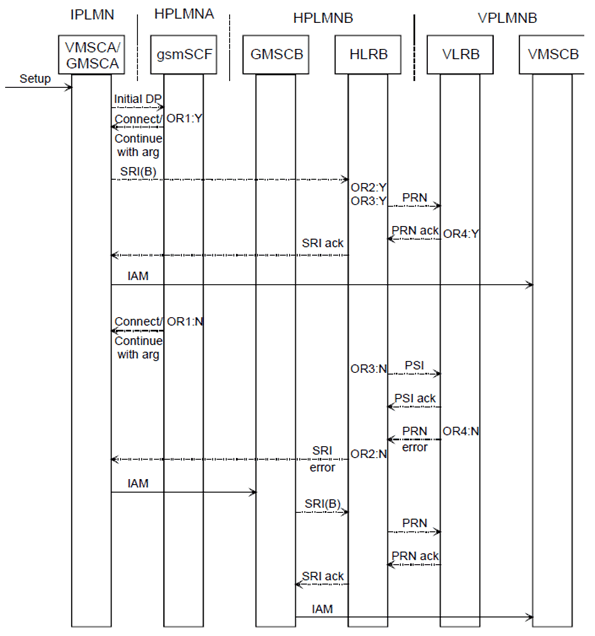Content for TS 23.079 Word version: 18.0.0
5 Optimal routeing for basic mobile-to-mobile calls: message flows
5.1 Successful outcome
5.2 Unsuccessful outcome
5.2.1 B subscriber address not recognised as belonging to a UMTS or GSM PLMN
5.2.2 HLRB or VLRB does not support optimal routeing
5.2.3 OR charging requirements contravened
...
...
5 Optimal routeing for basic mobile-to-mobile calls: message flows p. 10
It is a network operator option whether to implement optimal routeing for basic mobile-to-mobile calls.
This clause does not consider the handling of calls to a fixed network B subscriber.
The description in this clause of the handling of optimal routeing for basic mobile-to-mobile calls is informative, not normative. Further, the description does not consider the effects of other services or features, except where these are specifically mentioned.
The message flow for an optimally routed call from one mobile subscriber to another mobile subscriber is shown in Figure 3. For simplicity of description, it is assumed that forwarding of calls from the B subscriber is not required. Solid lines indicate circuit-associated signalling; dashed lines indicate connectionless signalling.

Figure 3: Message flow for optimal routeing of basic mobile-to-mobile call
(⇒ copy of original 3GPP image)
(⇒ copy of original 3GPP image)
5.1 Successful outcome p. 11
When VMSCA receives a Setup message from the MS, it sends a request for information to handle the outgoing call to VLRA, according to the procedures described in TS 23.018. If VLRA determines that the MS is allowed service, it returns a positive acknowledgement, including an indication that the subscriber has a CAMEL subscription, so that VMSCA will request instructions via the gsmSSF (not shown in this diagram) from the gsmSCF.
If the gsmSCF recognises the B subscriber address as belonging to a UMTS or GSM PLMN (decision OR1:Y), it sends a Connect message or a Continue With Argument message, containing an indication that the call is eligible for optimal routeing, to VMSCA. This causes VMSCA to route the call to the associated GMSC function (GMSCA). GMSCA checks the identity of HPLMNB. If GMSCA is in a different PLMN from HLRB, it then sends a request for routeing information (SRI(B)) to HLRB; this request contains an indication that it is an optimal routeing enquiry for information to route a basic call. If HLRB is prepared to accept an optimal routeing enquiry from GMSCA (decision OR2:Y), it checks whether at least one of the three conditions:
- the GMSC is in the same country as VMSCB;
- the HLR is in the same country as VMSCB;
- the GMSC is in the same PLMN as the HLR;
5.2 Unsuccessful outcome p. 12
Error situations which lead to failure of the call, rather than non-optimal routeing, are not described in this clause.
5.2.1 B subscriber address not recognised as belonging to a UMTS or GSM PLMN p. 12
If the gsmSCF does not recognise the B subscriber address as belonging to a UMTS or GSM PLMN (decision OR1:N), it sends a Connect or Continue With Argument message, omitting the indication that the call is eligible for optimal routeing. VMSCA constructs an IAM using the B subscriber address and sends it to GMSCB in HPLMNB. GMSCB analyses the address received in the IAM, and sends a request for routeing information (SRI(B)) to HLRB; this request contains an indication that it is not an optimal routeing enquiry. Because GMSCB is in the same PLMN as HLRB, it will always be able to derive an HLR address. HLRB sends a request for a roaming number (PRN) to VLRB. VLRB returns the roaming number in the PRN ack, and HLRB relays the roaming number in the SRI ack to GMSCB. GMSCB constructs an ISUP IAM using the roaming number, and sends it to VMSCB, which processes the incoming IAM according to the procedures described in TS 23.018.
5.2.2 HLRB or VLRB does not support optimal routeing p. 12
If HLRB is not prepared to accept an optimal routeing enquiry from GMSCA , because:
- it does not support optimal routeing for basic mobile-to-mobile calls, or
- because there is no agreement for optimal routeing for basic mobile-to-mobile calls between the operators of GMSCA and HLRB, or
- because optimal routeing of basic mobile-to-mobile calls to the specific B subscriber is not allowed,
5.2.3 OR charging requirements contravened p. 12
If HLRB determines that the call cannot be routed directly from GMSCA to VMSCB without contravening the charging requirements for optimal routeing given in clause 9.1 (decision OR3:N) it sends a request for subscriber information (PSI) to VLRB. VLRB sends a response indicating whether the B subscriber is detached or in some other state. If the B subscriber is not detached, HLRB sends an SRI negative response (shown in figure 3 as 'SRI error') to GMSCA, which constructs an IAM using the B subscriber address and sends it to GMSCB, as described in clause 5.2.1.